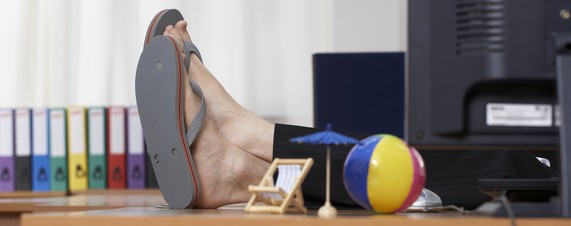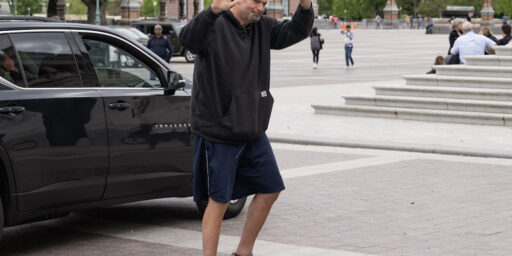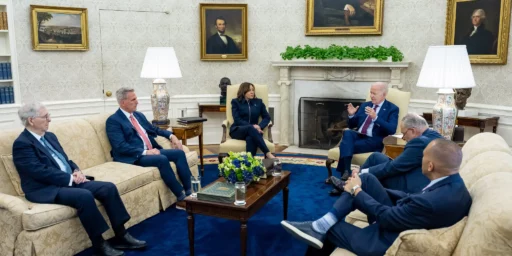What’s ‘Appropriate’ Office Attire?
Have Americans taken casual wear at the office too far? Most Americans seem to think so.
Have Americans taken casual wear at the office too far? Most Americans seem to think so.
Melissa Korn, WSJ At Work blog (“What Not to Wear To Work“):
A new survey shows U.S. adults expressing more outrage at scantily-clad co-workers this year than they did last year.
The report, commissioned by temporary staffing firm Adecco and based on interviews with more than 1,000 U.S. adults, found that 72% of Americans believe strapless or backless tops and dresses are “inappropriate for the workplace,” up from 66% (strapless) and 64% (backless) in June of last year.
Showing a little skin below the knee by wearing shorts, flip-flops or open-toed shoes is also a bigger no-no this year. Fifty-nine percent of respondents say shorts are inappropriate at the office, up from 55% last year. Meanwhile, 76% said flip-flops aren’t appropriate attire, up from 71%, and the percentage that disapproved of open-toed shoes in general increased to 35% from 31%.
Mini-skirts, while still meeting with disapproval by 69% of respondents, are slightly more acceptable this year than last year, when 70% said they were inappropriate.
Let’s stipulate that tiny fluctuations in such a poll don’t tell us much about trends. Still, the overall numbers are interesting.
Office cultures vary considerably, so what’s “appropriate” varies as well. I wear a business suit to work almost every day, sometimes wearing a sport coat and tie to change things up. That’s pretty standard for men in my office. Younger staffers tend not to wear a jacket, but the males wear long sleeved shirts and ties. At my late wife’s office, by contrast, shorts, t-shirts, and flip-flops are pretty standard.
Women tend to have a lot more flexibility. Even at my office, which is pretty formal by modern American standards, there’s huge variation in what the women wear. While men are in shirts and ties year-round, the women tend to dress seasonably, with substantial differences by age. Those in their 40s and 50s, who are more senior on the org chart as well, tend to wear pants suits and the like. Those in their 20s and 30s, though, wear pretty much whatever they want. No shorts and t-shirts, of course, but sundresses, miniskirts, flip-flops, and the like are commonplace. Additionally, while the men tend to simply wear something to work and leave in the same outfit, the women often have changes of clothes and an array of shoes to change into depending on what’s happening that day. So, they may start the day in flip-flops and wind up wearing three different pairs of dress shoes over the course of the next eight hours.
Are flip-flops unacceptable? It really depends on the nature of the work, the culture of the profession and region, and the age and appearance of the person wearing them. (Let’s just say that those over 30 and men, generally, ought to refrain.)
Ditto shorts. If your job doesn’t require interacting with customers, or includes a lot of physical toil, there’s no obvious reason why you need to wear long pants in the summertime.
As for me, I’ve never worn the minimum I could get away with to the office. When I was an Army officer and wore BDU’s to work every day, they were pressed and the boots polished. When I was teaching college, I wore a jacket and tie even though I could have worn jeans and a t-shirt and most of my peers wore khakis and polos. In DC, it’s almost impossible to over-dress, since business suits and cuff links are commonplace, especially for the over-30 set.
Frankly, none of this is all that hard. Look around the office and figure out what people are wearing. If it’s a typical office environment, emulate those a rung or two up the ladder from you in formality. If a large number of your peers are wearing shorts and flip-flops, it’s probably acceptable; if your boss is doing the same, it’s certainly acceptable. If, on the other hand, most everyone is wearing khakis and polos—or, certainly, coats and ties—it’s not.







I agree…it’s always been my philosophy that it’s better to be the best dressed person in the room than the worst!
I remember a couple of the professors in grad school would tease me because I would wear a jacket and tie on the days I taught while they dressed much more casually!
I have to say in my experience the work attire thing breaks down almost exactly by gender and age.
I’ve almost never seen men dress inappropriately in the workplace. The only exception that comes to mind were two bankruptcy attorneys who wore shorts and Florida shirts in the office. It made them look less than stupid, but then again they were named partners, it was their office, and it was during that national keg party of the late-1990’s. Women, however, are an entirely different story. I’ve seen scores of women dressed inappropriately for the office. I saw that in the 1980’s. I saw it yesterday. And in all years in between. Many of whom I’ve seen sent home because of it. A few of whom I’ve sent home because of it. Too much skin and too casual have been and remain the primary culprits.
Of course the dichotomy by age groups goes without saying and needs no explanation as to causes.
As far as giving workers and prospective workers advice about what to wear and what not to wear I’ve always told them the following: (1) open your eyes; if during your interview nearly everyone was wearing business suits that’s a pretty strong clue you should be wearing a business suit, (2) read your employee handbook; there likely will be a section on proper attire, (3) if you have questions ask the HR Manager, (4) in any event err on the side of being overdressed as opposed to being underdressed.
D. C.-area IT services company here. In my office it’s pretty much jeans and polos or jeans and button-downs. If anyone comes in wearing a tie, we wonder if they’ve got a funeral to attend or something. Fridays during the summer are Hawaiian Shirt Days, unless there’s a customer meeting or some other reason not to. Senior management and account execs will generally wear a jacket and tie, but just about nobody else.
But nobody would even think to show up in shorts or flip-flops.
I read somewhere not long ago that when the job market is tight, as it has been for the past few years, people’s perceptions of the level of “formality” necessary in office dress become more conservative, which we seem to see in the data you presented.
Location plays an important role, too. In DC, suits and ties for men are the norm. In Los Angeles, a tee-shirt and a jacket are probably enough, depending on the job to some degree.
It’s similar in S. Florida: a suit, even a linen suit, is something a lawyer might wear to work, but open shirts with or without jackets are quite common.
Your last paragraph sums it up nicely – look around the office and see what people are wearing. Other than basic cleanliness and decency, what’s appropriate varies too widely to generalize. And I guess even “decency” depends beyond not showing genitals etc.
Flip-flops do vaguely annoy me, I’ll admit.
I’m not a particularly sharp dresser. I wear the basic uniform of the business casual workplace. It’s pretty easy if you’re a guy. The women have more options, and thus more pitfalls. It’s not like men (well, except for Meatloaf) have to be worried about showing too much cleavage.
There’s a reason we get mass mails each summer reminding us about appropriate work attire.
Ugh. I can not stand flip flops in the office. It is a huge pet peeve. No, I do not want to see your talons. No, no amount of bedazzled fippery attached to them will make them work appropriate.
Open toe shoes, on women, do not bother me. But 1000% no to flip flops. Add in a pair of Capri jeans on a woman over 40 and a top so skimpy I can see a good four inches of your bra strap? Ridiculous. Someone should be sending your bare-backed, muffin-topped, varicose-veined, buniony-taloned ass home without pay until you learn what to wear on casual day.
Ugh.
@Tsar Nicholas:
Solid advice.
Downtown San Francisco and Seattle tend to be “dress nice” places. The most dressed down I’ve been in my jobs has been “casual nice” – khaki pants, dress type shirt, loafer shoes or top-siders. If I was staying in the office to do the analytics then for me, “casual nice” worked. Much of the work involved meeting with clients much of the time, and that meant dress professionally.
There’s a general rule of thumb in the IT world that the better dressed you are, the less you actually know. I joke that I dress down to keep expectations low so that I always over-deliver. But I also need to be approachable in my job so I don’t want to appear to stuffy.
“Add in a pair of Capri jeans on a woman over 40 and a top so skimpy I can see a good four inches of your bra strap? Ridiculous. Someone should be sending your bare-backed, muffin-topped, varicose-veined, buniony-taloned ass home without pay until you learn what to wear on casual day.”
Make assumptions much? I’m well over 40 and have no muffin-top, varicose veins, or bunions. OTOH, I see many women in their 20s whose clothing reveals rolls hanging out all over, and who don’t know that toenails need to be both trimmed and cleaned from time to time.
Appropriate dress is appropriate dress, regardless of age, and showing too much skin does not belong at the office.
@Lynn Eggers: I’m pretty certain that the comments you highlighted were so specific as to be referring to a particular coworker, don’t you? And thus not an assumption.
@Gromitt Gunn: “I’m pretty certain that the comments you highlighted were so specific as to be referring to a particular coworker, don’t you? And thus not an assumption.”
Possibly… yet, I’ve heard enough comments like that addressed to older women in general that I can’t be sure. Perhaps the commentator should be more specific, if he is indeed referring to a particular person. And the age reference is irrelevant since no one should be at work revealing a muffin-top, 4 inches of bra strap and all the rest that he mentions.
Am I, a woman of well over 40, a bit sensitive on this? You bet!
Your basic philosophy here is likely one reason that you are successful.
I’m at the most casual office ever, but in my opinion, flip-flops are barely acceptable even on a beach. Kids trip in them constantly (hence why I call them trip-flops), they make noise, and most people have ugly or smelly feet. I’ll grant you that they’re easy to get on and off … so the f**k what?!
Well, being in CA and self-employed, I dress according to comfort. I love sandals (Teva, Keen, Reef), boots (Frye or Uggs), or Swedish clogs. Jeans with a white linen shirt are my mainstays. While clothes do reflect an image, what stands out is one’s conduct, actions and competency.
While doing business in Hawaii, I was surprised to find that a good quality Hawaiian shirt is suitable for most meetings.
A polo and Khakis is the most dressed-down attire I’d consider appearing at the office in. Generally, a shirt and tie with slacks is the norm, but I am part of a team that is constantly given no-notice taskings to deal with walk-in bigwigs and other customers.